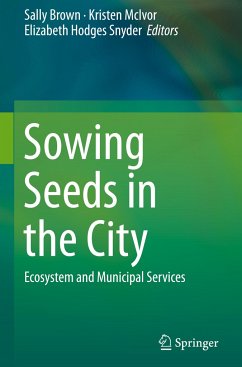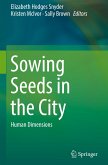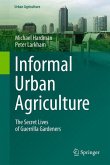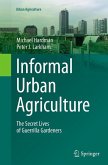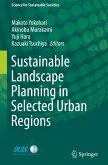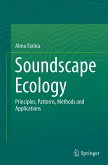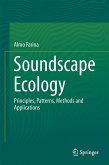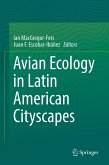Sowing Seeds in the City
Ecosystem and Municipal Services
Herausgegeben:Brown, Sally; McIvor, Kristen; Hodges Snyder, Elizabeth
Sowing Seeds in the City
Ecosystem and Municipal Services
Herausgegeben:Brown, Sally; McIvor, Kristen; Hodges Snyder, Elizabeth
- Gebundenes Buch
- Merkliste
- Auf die Merkliste
- Bewerten Bewerten
- Teilen
- Produkt teilen
- Produkterinnerung
- Produkterinnerung
Urban agriculture has the potential to change our food systems, enhance habitat in our cities, and to morph urban areas into regions that maximize rather than disrupt ecosystem services. The potential impacts of urban agriculture on a range of ecosystem services including soil and water conservation, waste recycling, climate change mitigation, habitat, and food production is only beginning to be recognized. Those impacts are the focus of this book. Growing food in cities can range from a tomato plant on a terrace to a commercial farm on an abandoned industrial site. Understanding the benefits…mehr
Andere Kunden interessierten sich auch für
![Sowing Seeds in the City Sowing Seeds in the City]() Sowing Seeds in the City134,99 €
Sowing Seeds in the City134,99 €![Informal Urban Agriculture Informal Urban Agriculture]() Michael HardmanInformal Urban Agriculture75,99 €
Michael HardmanInformal Urban Agriculture75,99 €![Informal Urban Agriculture Informal Urban Agriculture]() Michael HardmanInformal Urban Agriculture75,99 €
Michael HardmanInformal Urban Agriculture75,99 €![Sustainable Landscape Planning in Selected Urban Regions Sustainable Landscape Planning in Selected Urban Regions]() Sustainable Landscape Planning in Selected Urban Regions119,99 €
Sustainable Landscape Planning in Selected Urban Regions119,99 €![Soundscape Ecology Soundscape Ecology]() Almo FarinaSoundscape Ecology186,99 €
Almo FarinaSoundscape Ecology186,99 €![Soundscape Ecology Soundscape Ecology]() Almo FarinaSoundscape Ecology186,99 €
Almo FarinaSoundscape Ecology186,99 €![Avian Ecology in Latin American Cityscapes Avian Ecology in Latin American Cityscapes]() Avian Ecology in Latin American Cityscapes112,99 €
Avian Ecology in Latin American Cityscapes112,99 €-
-
-
Urban agriculture has the potential to change our food systems, enhance habitat in our cities, and to morph urban areas into regions that maximize rather than disrupt ecosystem services. The potential impacts of urban agriculture on a range of ecosystem services including soil and water conservation, waste recycling, climate change mitigation, habitat, and food production is only beginning to be recognized. Those impacts are the focus of this book. Growing food in cities can range from a tomato plant on a terrace to a commercial farm on an abandoned industrial site. Understanding the benefits of these activities across scales will help this movement flourish. Food can be grown in community gardens, on roofs, in abandoned industrial sites and next to sidewalks. The volume includes sections on where to grow food and how to integrate agriculture into municipal zoning and legal frameworks.
Produktdetails
- Produktdetails
- Verlag: Springer / Springer Netherlands
- Artikelnr. des Verlages: 978-94-017-7451-2
- 1st ed. 2016
- Seitenzahl: 424
- Erscheinungstermin: 9. Mai 2016
- Englisch
- Abmessung: 241mm x 160mm x 27mm
- Gewicht: 819g
- ISBN-13: 9789401774512
- ISBN-10: 940177451X
- Artikelnr.: 43761187
- Herstellerkennzeichnung Die Herstellerinformationen sind derzeit nicht verfügbar.
- Verlag: Springer / Springer Netherlands
- Artikelnr. des Verlages: 978-94-017-7451-2
- 1st ed. 2016
- Seitenzahl: 424
- Erscheinungstermin: 9. Mai 2016
- Englisch
- Abmessung: 241mm x 160mm x 27mm
- Gewicht: 819g
- ISBN-13: 9789401774512
- ISBN-10: 940177451X
- Artikelnr.: 43761187
- Herstellerkennzeichnung Die Herstellerinformationen sind derzeit nicht verfügbar.
Sally L Brown is a Research Associate Professor at the University of Washington School of Forest and Environmental Science. She is a Fellow in the Soil Science Society of America, was a two- term member of the National Academy of Science Standing Committee on Soil Science and a member on the National Academy of Science Committee on the Bioavailability of Contaminants in Soils and Sediments. She has won multiple awards for her work on residuals use in soils. Dr. Brown writes a monthly column for Biocycle Magazine, a journal that focuses on sustainable management of organics. She has a BA in Political Science from Williams College (1980) and a MS (1993) and PhD (1996) from the University of Maryland. Before returning to graduate school, she worked as a chef in New York City, New Orleans and Connecticut. In 1986 she started a business delivering locally grown vegetables to stores and restaurants in New York City and Connecticut. She currently grows greens, onions, potatoes and currants on two plots near her home with the assistance of her husband and Tagro, the biosolids based soil amendment from Tacoma, WA. Kristen McIvor is the director of Harvest Pierce County, a program of the Pierce Conservation District. Their mission is to invest in people to foster and sustain an equitable and healthy community-based food system throughout Pierce County. She is also an adjunct professor at Antioch University Seattle where she teaches classes on food systems. Dr. McIvor got her MS at Antioch in Environment and Community and her PhD at the University of Washington. Her academic work has focused on improving soils in urban areas to support the growing of food, and much of her time is spent working with community groups to do just that. She lives in the drippy Pacific Northwest and loves its mild climate for year-round growing. In her spare time, she gets her hands dirty as often as she can, and lovespreparing and sharing the bounty of her garden with her family and friends. Elizabeth Hodges Snyder is an Assistant Professor of Public Health and the Master of Public Health Program Coordinator at the University of Alaska Anchorage. She also serves as co-chair of the Alaska Food Policy Council (AFPC). Dr. Snyder is trained in environmental health (MPH, Global Environmental Health, Emory University, 2004) and soil and water science (PhD, Soil and Water Science, University of Florida, 2009). Her career began with a focus on environmental contaminant fate and transport, and human and ecological risk assessment, but her research program and teaching agenda has since evolved to address the fields of food security and health impact assessment. She has co-authored several works on food security in Alaska; supervises graduate student projects addressing food access, availability, and utilization; and advocates for strengthened rural and urban food systems. Originally from Florida, Dr. Snyder has adjusted well to the climate of Alaska - successfully raising backyard chickens, utilizing vertical drip irrigation to produce greenhouse tomatoes, growing beautiful peonies, chasing moose out of her raised beds, and instilling in her children a love for Alaska Grown carrots made sugar-sweet in the cold soil.
Preface.- Chapter 1. Introduction: Ecosystem Services from Urban Agriculture in the City of the Future.- Part I: Soil and Water Resources.- Chapter 2: Soil Formation and Nutrient Cycling.- Chapter 3: A Guide to Types of Non Potable Water and the Potential for Reuse in Urban Systems.- Chapter 4: Graywater Reuse For Irrigation: Benefits and Potential Hazards.- Chapter 5: Planting Abundance: Alternative Water Sources for Urban Farms.- Part II: Ecosystem Services - Waste Treatment.- Chapter 6: The Role of Organic Residuals in Urban Agriculture.- Chapter 7: Municipal Food Waste Management Options: Climate and Economic Impacts.- Chapter 8: Food Waste Composting in Seattle: The Political Perspective.- Chapter 9: Cedar Grove Compost: Developing a Combined Food- Yard Waste Centralized Composting Program.- Part III: Ecosystem Services - Climate Regulation.- Chapter 10: Soils and Climate Change.- Chapter 11: Soil Carbon Sequestration and Organic Wastes.- Chapter 12: Lettuce to Reduce Greenhouse Gases: A Comparative Life Cycle Assessment of Conventional and Community Agriculture.- Part IV: Ecosystem Services - Habitat.- Chapter 13: Basics of Microbial Ecology and Function in Urban Agriculture.- Chapter 14: Urban Microbiomes and Urban Agriculture: What Are The Connections and Why Should We Care?.- Chapter 15: Wild Bees in Cultivated City Gardens.- Chapter 16: Urban Agriculture as Habitat for Birds.- Chapter 17: Improving the Suitability of Urban Farms for Wildlife.- Part V: Ecosystem Services - Food Production.- Chapter 18: How Much Can You Grow? Quantifying Yield in a Community Garden Plot: One Family's Experience.- Chapter 19: Applying Permaculture in Alaska: The Williams Street Farmhouse.- Chapter 20: Seed Libraries.- Chapter 21: Recirculating Aquaculture Systems (RAS) and Aquaponics for Urban Food Production, with a Pictorial Guide to Aquaponics.- Part VI: Integration into Municipal Infrastructure - Location Options.- Chapter 22: Community Garden Basics.- Chapter 23: Up on the Roof: Considerations for Food Production on Rooftops.- Chapter 24: Brownfields as Sites for Urban Farms.- Chapter 25: Curbside Gardens.- Part VII: Integration into Municipal Infrastructure - Zoning and Legal Considerations.- Chapter 26: Zoning and Urban Agriculture in Michigan.- Chapter 27: Urban Agriculture in Portland, Oregon: 2002-2012.- Chapter 28: Legalizing Commercial Agriculture in Boston: A Logical Step Towards Integrating Farming Into Urban Life.
Preface.- Chapter 1. Introduction: Ecosystem Services from Urban Agriculture in the City of the Future.- Part I: Soil and Water Resources.- Chapter 2: Soil Formation and Nutrient Cycling.- Chapter 3: A Guide to Types of Non Potable Water and the Potential for Reuse in Urban Systems.- Chapter 4: Graywater Reuse For Irrigation: Benefits and Potential Hazards.- Chapter 5: Planting Abundance: Alternative Water Sources for Urban Farms.- Part II: Ecosystem Services - Waste Treatment.- Chapter 6: The Role of Organic Residuals in Urban Agriculture.- Chapter 7: Municipal Food Waste Management Options: Climate and Economic Impacts.- Chapter 8: Food Waste Composting in Seattle: The Political Perspective.- Chapter 9: Cedar Grove Compost: Developing a Combined Food- Yard Waste Centralized Composting Program.- Part III: Ecosystem Services - Climate Regulation.- Chapter 10: Soils and Climate Change.- Chapter 11: Soil Carbon Sequestration and Organic Wastes.- Chapter 12: Lettuce to Reduce Greenhouse Gases: A Comparative Life Cycle Assessment of Conventional and Community Agriculture.- Part IV: Ecosystem Services - Habitat.- Chapter 13: Basics of Microbial Ecology and Function in Urban Agriculture.- Chapter 14: Urban Microbiomes and Urban Agriculture: What Are The Connections and Why Should We Care?.- Chapter 15: Wild Bees in Cultivated City Gardens.- Chapter 16: Urban Agriculture as Habitat for Birds.- Chapter 17: Improving the Suitability of Urban Farms for Wildlife.- Part V: Ecosystem Services - Food Production.- Chapter 18: How Much Can You Grow? Quantifying Yield in a Community Garden Plot: One Family's Experience.- Chapter 19: Applying Permaculture in Alaska: The Williams Street Farmhouse.- Chapter 20: Seed Libraries.- Chapter 21: Recirculating Aquaculture Systems (RAS) and Aquaponics for Urban Food Production, with a Pictorial Guide to Aquaponics.- Part VI: Integration into Municipal Infrastructure - Location Options.- Chapter 22: Community Garden Basics.- Chapter 23: Up on the Roof: Considerations for Food Production on Rooftops.- Chapter 24: Brownfields as Sites for Urban Farms.- Chapter 25: Curbside Gardens.- Part VII: Integration into Municipal Infrastructure - Zoning and Legal Considerations.- Chapter 26: Zoning and Urban Agriculture in Michigan.- Chapter 27: Urban Agriculture in Portland, Oregon: 2002-2012.- Chapter 28: Legalizing Commercial Agriculture in Boston: A Logical Step Towards Integrating Farming Into Urban Life.

